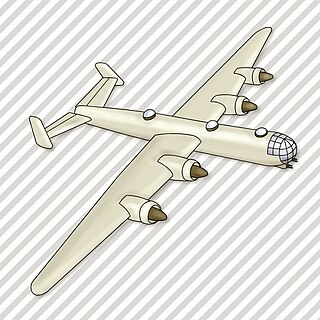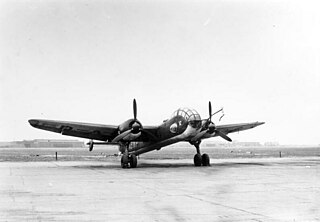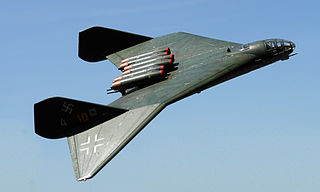Development
The Mistel V was a composite bomber comprising a Heinkel He 162A-2 piloted component and a specially developed Arado E377 glider bomb. Due to shortages at the Arado design offices, several other composites were studied as replacements for the Arado E377, and in late 1944 Junkers proposed the Ju268 as an alternate bomber component for the Mistel V, with a Messerschmitt Me 262 studied as an alternative piloted component.
The Ju 268 was simply designed with wooden structure and a nose equipped with a so-called "Voreilzunder", which already was used on some Ju 88 aircraft a re-usable jettisonable undercarriage dolly, and BMW 003 or Jumo 004 turbojet engines with BMW 028 booster rocket engines.
A bomb payload of 10 tons could be loaded and a speed of 800 km/h was projected, for kamikaze missions a manned version of the Ju 268 was under study with a glazed cockpit section in the front of the aircraft. The Ju 268 was not built.

The Focke-Wulf Ta 154 Moskito was a fast twin-engined German night fighter aircraft designed by Kurt Tank and produced by Focke-Wulf during late World War II. Only a few were produced, proving to have less impressive performance than the prototypes.

The Arado Ar 234 Blitz was the world's first operational jet-powered bomber, built by the German Arado company during World War II.

The Junkers Ju 388Störtebeker is a World War II German Luftwaffe multi-role aircraft based on the Ju 88 airframe by way of the Ju 188. It differed from its predecessors in being intended for high altitude operation, with design features such as a pressurized cockpit for its crew. The Ju 388 was introduced very late in the war, and production problems along with the deteriorating war conditions meant that few were built.

The Junkers Ju 188 was a German Luftwaffe high-performance medium bomber built during World War II, the planned follow-up to the Ju 88 with better performance and payload. It was produced only in limited numbers, due both to the presence of improved versions of the Ju 88, as well as the increasingly effective Allied strategic bombing campaign against German industry and the resulting focus on fighter production.

A flying bomb is a manned or unmanned aerial vehicle or aircraft carrying a large explosive warhead, a precursor to contemporary cruise missiles. In contrast to a bomber aircraft, which is intended to release bombs and then return to its base for re-use, a flying bomb crashes into its target and is therefore itself destroyed in its attack.

The Amerikabomber project was an initiative of the German Ministry of Aviation (Reichsluftfahrtministerium) to obtain a long-range strategic bomber for the Luftwaffe that would be capable of striking the United States from Germany, a round-trip distance of about 11,600 km (7,200 mi). The concept was raised as early as 1938, but advanced plans for such a long-range strategic bomber design did not begin to appear before Reichsmarschall Hermann Göring until early 1942. Various proposals were put forward, but these plans were all eventually abandoned as they were too expensive, too reliant on rapidly-diminishing materiel and production capacity, and/or technically unfeasible.

The Heinkel He 277 was a four-engine, long-range heavy bomber design, originating as a derivative of the He 177, intended for production and use by the German Luftwaffe during World War II. The main difference was in its engines. The He 177 used two Daimler-Benz DB 606 "power system" engines, each of which consisted of two combined Daimler-Benz DB 601 engines, each DB 606 weighed 1.5 tons. The He 177A-3 and its successors used two DB 610 "power system" engines, each of which consisted of two combined Daimler-Benz DB 605 engines, each DB 610 weighed 1.5 tons. Due to problems with both the DB 606 and the DB 610, the He 277 was intended to use four unitized BMW 801E 14-cylinder radial engines, each mounted in an individual nacelle and each turning a three-blade, four-meter diameter propeller.

The Junkers Ju 287 was an aerodynamic testbed built in Nazi Germany to develop the technology required for a multi-engine jet bomber. It was powered by four Junkers Jumo 004 engines, featured an unusual and novel forward-swept wing, and apart from the wing was assembled largely from components scavenged from other aircraft. It was one of the very few jet propelled aircraft ever built with fixed landing gear.

Mistel was the larger, unmanned component of a composite aircraft configuration developed in Germany during the later stages of World War II. The composite comprised a small piloted control aircraft mounted above a large explosives-carrying drone, the Mistel, and as a whole was referred to as the Huckepack ("Piggyback"), also known as the Beethoven-Gerät or Vati und Sohn.

Bomber B was a German military aircraft design competition organised just before the start of World War II to develop a second-generation high-speed bomber for the Luftwaffe. The new designs would be a direct successor to the Schnellbomber philosophy of the Dornier Do 17 and Junkers Ju 88, relying on high speed as its primary defence. Bomber B would also be a much larger and more capable aircraft, with range and payload far greater than the Schnellbomber, besting even the largest conventional designs then under consideration. The winning design was intended to form the backbone of the Luftwaffe's bomber force, replacing the wide collection of semi-specialized designs then in service. The Reich Air Ministry was so optimistic that more modest projects were generally cancelled; when the project failed the Luftwaffe was left with hopelessly outdated aircraft.
Kampfgeschwader 200 was a German Luftwaffe special operations unit during World War II. The unit carried out especially difficult bombing and transport operations and long-distance reconnaissance flights, tested new aircraft designs and operated captured aircraft.

The Emergency Fighter Program was the program that resulted from a decision taken on July 3, 1944 by the Luftwaffe regarding the German aircraft manufacturing companies during the last year of the Third Reich.

Wunderwaffe is German for "wonder-weapon" and was a term assigned during World War II by Nazi Germany's propaganda ministry to some revolutionary "superweapons". Most of these weapons however remained prototypes, which either never reached the combat theater, or if they did, were too late or in too insignificant numbers to have a military effect.

The Arado E.555 was a long range strategic bomber proposed by the German Arado company during World War II in response to the RLM's Amerikabomber project. The E.555 designation was applied to a series of long range jet bomber designs of various sizes, powerplant, crew and weapon load configurations. As design studies only, no aircraft were developed or constructed and the entire E.555 project was cancelled at the end of 1944.

The Leonidas Squadron, formally known as 5th Staffel of Kampfgeschwader 200, was a unit which was originally formed to fly the Fieseler Fi 103R (Reichenberg), a manned version of the V-1 flying bomb, in attacks in which the pilot was likely to be killed, or at best to parachute down at the attack site. The Reichenberg was never used in combat because Werner Baumbach, the commander of KG 200, and his superiors considered it an unnecessary waste of life and resources, and preferred to use the Mistel composite aircraft aerial ordnance system instead. The Mistel composite design was piloted from a regular Luftwaffe single-seat fighter used as the "upper component" forming the guidance system, mounted as an integral parasite aircraft, as the only manned part, mounted atop the unmanned, shaped charge-nosed "expendable lower component" of the Mistel aircraft system, as in its target dive, the single-seat pilot released the lower, unmanned flying bomb component aircraft towards its target, while the upper component, manned fighter "guidance component" returned to base.
A composite aircraft is made up of multiple component craft. It takes off and flies initially as a single aircraft, with the components able to separate in flight and continue as independent aircraft. Typically the larger aircraft acts as a carrier aircraft or mother ship, with the smaller sometimes called a parasite or jockey craft.
The Arado Ar 81 was a German prototype dive bomber. Because the Reich Air Ministry decided to purchase the competing Junkers Ju 87, only three prototypes of the Ar 81 were completed.

The Arado Ar E.340 was a twin-engined dive- and tactical-medium bomber, designed by Arado Flugzeugwerke at the request of the Reich Air Ministry in 1939 to compete for a production contract for the Bomber B fast bomber design competition, but the project was cancelled.














